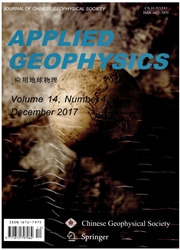

 中文摘要:
中文摘要:
航空电磁法具有高采样率探测特征,传统数值模拟方法为保证航电响应计算精度,特别是针对复杂地质体(如电各向异性),需要对模拟域进行精细剖分,导致计算工作量庞大。因此本文采用谱元法对航空电磁各向异性响应进行三维正演模拟,该方法结合谱方法和有限元法双重优势,它与谱方法类似采样高阶基函数代替有限元中的线性插值,同时具有有限元拟合边界的灵活性。因此该方法能改善离散网格内部的数值模拟精度,减弱数值模拟结果对网格的依赖性,实现航空电磁各向异性响应的高精度计算。首先,本文将旋转张量的各向异性电导率引入Maxwell方程,并给出GLL谱元基函数给出电场表示形式,采用伽辽金加权余量法形成基于谱元法大型线性方程组获得电磁响应,以VMD发射源为例进行航空电磁响应模拟。其次,本文采用粗物理网格四阶谱元法对任意各向异性半空间的航空电磁响应进行计算,通过与一维半解析解对比验证了该算法的高精度性。再次,本文采用不同物理网格和谱元阶数讨论不同各向异性条件下三维异常体的航空电磁响应,得出了不同各向异性异常体的电磁响应的收敛条件。最后,本文首次基于谱元算法,采用Hr/Hz方式给出了三维各向异性异常体,各向异性围岩以及围岩和异常体同时存在各向异性时航空电磁各向异性的识别方式,这航空电磁各向异性的三维反演和各向异性地质区域测量具有指导意义。
 英文摘要:
英文摘要:
The airborne electromagnetic (AEM) method has a high sampling rate and survey flexibility. However, traditional numerical modeling approaches must use high-resolution physical grids to guarantee modeling accuracy, especially for complex geological structures such as anisotropic earth. This can lead to huge computational costs. To solve this problem, we propose a spectral-element (SE) method for 3D AEM anisotropic modeling, which combines the advantages of spectral and finite-element methods. Thus, the SE method has accuracy as high as that of the spectral method and the ability to model complex geology inherited from the finite-element method. The SE method can improve the modeling accuracy within discrete grids and reduce the dependence of modeling results on the grids. This helps achieve high-accuracy anisotropic AEM modeling. We first introduced a rotating tensor of anisotropic conductivity to Maxwell's equations and described the electrical field via SE basis functions based on GLL interpolation polynomials. We used the Galerkin weighted residual method to establish the linear equation system for the SE method, and we took a vertical magnetic dipole as the transmission source for our AEM modeling. We then applied fourth-order SE calculations with coarse physical grids to check the accuracy of our modeling results against a 1D semi-analytical solution for an anisotropic half-space model and verified the high accuracy of the SE. Moreover, we conducted AEM modeling for different anisotropic 3D abnormal bodies using two physical grid scales and three orders of SE to obtain the convergence conditions for different anisotropic abnormal bodies. Finally, we studied the identification of anisotropy for single anisotropic abnormal bodies, anisotropic surrounding rock, and single anisotropic abnormal body embedded in an anisotropic surrounding rock. This approach will play a key role in the inversion and interpretation of AEM data collected in regions with anisotropic geology.
 同期刊论文项目
同期刊论文项目
 同项目期刊论文
同项目期刊论文
 期刊信息
期刊信息
